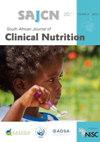Nutrition support in critical care: How does a South African unit measure up against the suggested guidelines and against the world?
IF 0.6
Q4 NUTRITION & DIETETICS
引用次数: 0
Abstract
Both the European Society for Clinical Nutrition and Metabolism (ESPEN) and the American Society of Parenteral and Enteral Nutrition (ASPEN) in their published guidelines agreed that indirect calorimetry (IC) should be used to determine energy requirements in the critically ill patients, where feasible and available. 3 However, ESPEN advocated a progressive implementation of energy provision. In this approach, hypocaloric nutrition not exceeding 70% of energy expenditure, in the early phase of acute illness was recommended. Provision of 80–100% of requirements should only be implemented after 72 hours following admission. In the absence of IC, ASPEN and ESPEN suggest that simple weight-based equations be used. 3 The ASPEN 2016 guidelines gave a range of 25–30 kCal/kg/day. ESPEN however suggested that hypocaloric nutrition support, below 70% of estimated needs, should be continued for the first week of ICU stay when weight-based equations are being used. The reasoning behind progressively increasing energy provision in the critical care setting by ESPEN is based on earlier data (Tappy et al. 1998), which showed that exogenous glucose provision does not suppress endogenous glucose production. Endogenous energy production, which occurs in the early phase of critical illness, can provide 500–1 400 kCal/day. 4 Currently, it is not possible to measure this endogenous production at the point-of-care, however providing full measured or calculated requirements during this stage would result in overfeeding. 4重症监护中的营养支持:南非的一个单位如何与建议的指导方针和世界接轨?
欧洲临床营养与代谢学会(ESPEN)和美国肠外和肠内营养学会(ASPEN)在其发布的指南中都同意,在可行和可用的情况下,应使用间接量热法(IC)来确定危重患者的能量需求。3然而,ESPEN主张逐步实施能源供应。在这种方法中,建议在急性疾病的早期阶段,低热量营养不超过能量消耗的70%。只有在入院后72小时后才能实施80-100%的要求。在没有IC的情况下,ASPEN和ESPEN建议使用简单的基于权重的方程。3 ASPEN 2016指南给出的范围为25-30 kCal/kg/天。然而,ESPEN建议,当使用基于体重的方程时,应在ICU住院的第一周继续提供低于估计需求70%的低热量营养支持。ESPEN在重症监护环境中逐渐增加能量供应的原因是基于早期数据(Tappy等人,1998),该数据表明外源性葡萄糖供应不会抑制内源性葡萄糖的产生。内源性能量产生发生在危重症的早期,每天可提供500–1400千卡。4目前,不可能在护理点测量这种内源性生产,但在此阶段提供完整的测量或计算需求会导致过量喂养。4.
本文章由计算机程序翻译,如有差异,请以英文原文为准。
求助全文
约1分钟内获得全文
求助全文
来源期刊

South African Journal of Clinical Nutrition
NUTRITION & DIETETICS-
CiteScore
2.50
自引率
9.10%
发文量
21
期刊介绍:
1.The Journal accepts articles from all basic and applied areas of dietetics and human nutrition, including clinical nutrition, community nutrition, food science, food policy, food service management, nutrition policy and public health nutrition. 2.The Journal has a broad interpretation of the field of nutrition and recognizes that there are many factors that determine nutritional status and that need to be the subject of scientific investigation and reported in the Journal. 3.The Journal seeks to serve a broad readership and to provide information that will be useful to the scientific community, the academic community, government and non-government stakeholders in the nutrition field, policy makers and industry.
 求助内容:
求助内容: 应助结果提醒方式:
应助结果提醒方式:


